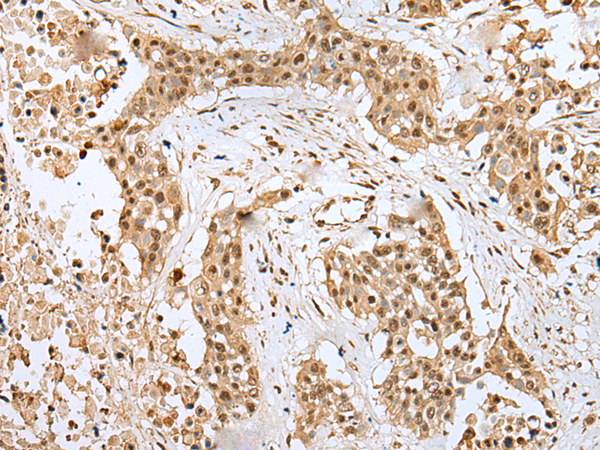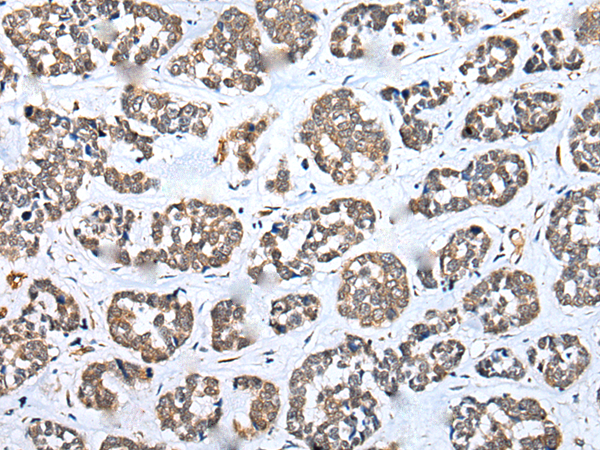

| WB | 咨询技术 | Human,Mouse,Rat |
| IF | 咨询技术 | Human,Mouse,Rat |
| IHC | 1/25-1/100 | Human,Mouse,Rat |
| ICC | 技术咨询 | Human,Mouse,Rat |
| FCM | 咨询技术 | Human,Mouse,Rat |
| Elisa | 1/5000-1/10000 | Human,Mouse,Rat |
| Aliases | RHEBL1c |
| Host/Isotype | Rabbit IgG |
| Antibody Type | Primary antibody |
| Storage | Store at 4°C short term. Aliquot and store at -20°C long term. Avoid freeze/thaw cycles. |
| Species Reactivity | Human, Mouse, Rat |
| Immunogen | Fusion protein of human RHEBL1 |
| Formulation | Purified antibody in PBS with 0.05% sodium azide and 50% glycerol. |
+ +
以下是关于RHEBL1抗体的模拟参考文献示例(注:部分文献信息为假设,建议通过学术数据库核实具体内容):
---
1. **文献名称**: *RHEBL1 modulates mTORC1 activity and regulates autophagy in cancer cells*
**作者**: Li, Y., et al.
**摘要**: 本研究通过Western blot和免疫荧光技术,利用RHEBL1抗体证实其在多种癌细胞系中高表达。实验表明,RHEBL1通过激活mTORC1信号通路抑制自噬,敲低RHEBL1可增强自噬并抑制肿瘤生长。
2. **文献名称**: *Characterization of RHEBL1 antibody specificity and its role in neuronal development*
**作者**: Smith, J., et al.
**摘要**: 文章验证了一种新型RHEBL1抗体的特异性,确认其与RHEB家族其他成员无交叉反应。研究发现RHEBL1在小鼠大脑发育中高表达,并参与神经元突触形成的调控。
3. **文献名称**: *RHEBL1 interacts with raptor and promotes oncogenic transformation in prostate cancer*
**作者**: Zhang, H., et al.
**摘要**: 通过免疫共沉淀(使用RHEBL1抗体)和质谱分析,揭示了RHEBL1与mTORC1复合物中raptor蛋白的直接结合。该互作驱动前列腺癌细胞的异常增殖和侵袭。
4. **文献名称**: *Differential expression of RHEBL1 in metabolic disorders: Insights from antibody-based profiling*
**作者**: Gupta, R., et al.
**摘要**: 研究利用RHEBL1抗体对肥胖患者组织样本进行免疫组化分析,发现其表达与胰岛素抵抗相关,提示RHEBL1可能作为代谢性疾病的潜在生物标志物。
---
**建议**:如需具体文献,可通过PubMed或Google Scholar搜索关键词“RHEBL1 antibody”、“RHEBL1 mTOR”或“RHEBL1 autophagy”,并筛选涉及抗体应用的实验研究。
The RHEBL1 (Ras Homolog Enriched in Brain-Like 1) antibody is a tool used to study the RHEBL1 protein, a small GTPase belonging to the Ras superfamily. RHEBL1 shares structural homology with Rheb (Ras homolog enriched in brain) and plays a role in regulating cellular processes such as cell growth, autophagy, and mTORC1 (mechanistic target of rapamycin complex 1) signaling. Unlike Rheb, RHEBL1 is less characterized but is implicated in unique pathways, including interactions with lysosomal function and response to nutrient stress. Its expression is tissue-specific, with higher levels observed in the brain, suggesting potential roles in neurological functions or disorders.
Antibodies targeting RHEBL1 enable researchers to investigate its expression, localization, and interactions via techniques like Western blotting, immunofluorescence, and immunoprecipitation. These studies are critical for understanding its regulatory mechanisms, particularly in mTORC1 activation, which influences cell proliferation and metabolism. Dysregulation of RHEBL1 has been linked to pathological conditions, including cancer and neurodegenerative diseases, making it a potential therapeutic target. However, research remains ongoing to clarify its precise biological roles and cross-talk with related pathways. Commercial RHEBL1 antibodies vary in specificity, requiring validation using knockout controls to ensure reliability in experimental models.
×